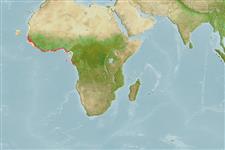Common names from other countries
>
Carangaria/misc (Various families in series Carangaria) >
Polynemidae (Threadfins)
Etymology: Polydactylus: Greek, poly = a lot of + greek, daktylos = finger (Ref. 45335).
More on author: Cuvier.
Environment: milieu / climate zone / depth range / distribution range
Ecología
marino; agua dulce; salobre demersal; rango de profundidad 15 - 55 m (Ref. 10799). Tropical; 22°N - 5°S, 26°W - 13°E (Ref. 57343)
Eastern Atlantic: Senegal to Angola (Ref. 57402). Also reported from Mauritania (Ref. 55783).
Tamaño / Peso / Age
Maturity: Lm ? range ? - ? cm
Max length : 200 cm TL macho / no sexado; (Ref. 57402); common length : 150 cm TL macho / no sexado; (Ref. 3659); peso máximo publicado: 75.0 kg (Ref. 7386)
Espinas dorsales (total) : 9; Radios blandos dorsales (total) : 12 - 13; Espinas anales: 3; Radios blandos anales: 11 - 12. Diagnosis: pectoral fin with 4 threadlike filaments (Ref. 57402, 81658). Pectoral fin inserted very low on body, generally somewhat longer than upper part of fin (Ref. 57402).
Occurs in shallow coastal waters, over sandy and muddy bottoms, sometimes in brackish habitats (Ref. 57343, 81658). Enters estuaries (Ref. 57402), occasionally caught in fresh water (Ref. 57402, 81658). Very large specimens are only found in marine waters (Ref. 81658). Feeds on crustaceans and fishes (Ref. 10799, 81658). Flesh fairly tasteful (Ref. 57402).
Life cycle and mating behavior
Maturities | Reproducción | Spawnings | Egg(s) | Fecundities | Larva
Motomura, H., 2004. Threadfins of the world (Family Polynemidae). An annotated and illustrated catalogue of polynemid species known to date. FAO Spec. Cat. Fish. Purp. Rome: FAO. 3:117 p. (Ref. 57343)
IUCN Red List Status (Ref. 130435)
CITES (Ref. 128078)
Not Evaluated
Threat to humans
Harmless
Human uses
Can't connect to MySQL database (fbapp). Errorcode: Too many connections
